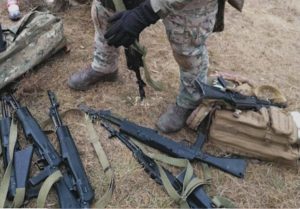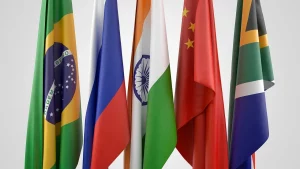
Planning the Russian attack on Lithuania: Estonia and Latvia are already occupied, but the attack will be fought off
The Center on New Generation Warfare has conducted planning for a Russian attack on Lithuania in 2027.
Their vision presentation was published on the Lrytas YouTube channel, one of the largest news portals in Lithuania.
It considers a scenario in which Estonia and Latvia have already been occupied. Former high-ranking military officers, including US Generals Philip Breedlove and Ben Hodges, participated in this computer military “game.”
In a simulated scenario of a Russian attack on NATO, it would take ten days for the Alliance to invoke Article 5, and German troops stationed in Lithuania played a key role in protecting the Baltic states.
“The purpose of the simulation was to model and analyze NATO’s response to a hypothetical Russian offensive to better understand the alliance’s capabilities and develop strategies to protect the Baltic states,” the speakers noted.
About 800 German soldiers serve in Lithuania as part of NATO’s “eFP battlegroup.” They are equipped with “a significant number of vehicles and weapons systems,” including several Leopard 2 tanks.
By the end of 2027, the German contingent is to increase to a full brigade (4,800 soldiers and 200 civilian staff) and 44 Leopard 2 tanks. And they are countering an attack from the Kaliningrad region, occupied Latvia, and Belarus.
This scenario is considered to be one of the most dangerous for Latvia, Lithuania, and Estonia: a frontal Russian attack on NATO’s eastern flank in the next three years.
The attack on Lithuania assumes an attack from Latvia.
According to the simulation, in the worst-case scenario, ten days would have passed before NATO countries would have invoked Article 5 (collective defense of the Alliance) and sent reinforcements to the affected Baltic states and to the Bundeswehr troops stationed there.
“We need to buy as much time as possible,” General Breedlove explains.
These are ten days during which the Baltic countries would have remained without foreign aid before Poland and other allies intervened.
At this stage, it looks quite logical, but then the forecast ignores the means that the Russians are already actively using in the war against Ukraine. For example, from the quote of General Breedlove, he says:
“First, there will be air support, then the navy, and then heavy ground troops. We need to hold our positions until the arrival of large NATO forces,” he said.
The Russians’ advantage in long-range means of defeating air defense is not taken into account. For example, R-37 air-to-air missiles are superior in range to the AIM-120 missiles of Western partners, and Saab’s Meteor long-range missiles are not integrated into American-made aircraft. Likewise, new American developments such as AGM-174 and AIM-260 have not become widespread and are at the stage of gaining combat capabilities of units before they are used or developed.
Another controversial issue is the navy, as the Baltic Sea is a limited theater of operations and, apart from two Russian enclaves, is fully controlled by NATO. The situation there may mirror the Black Sea, where the superior Russian forces are limited in their actions due to the hybrid actions of the Ukrainian Defense Forces, which have far fewer anti-ship weapons. That is, to send the fleet there is to put oneself at a disadvantage in advance.
As for the heavy ground forces, we will write more on this scenario:
According to the scenario, Russia attacks from occupied Latvia, as well as from Belarus and Kaliningrad. Lithuania and its allies are forced to retreat, and a German tank battalion (!!!) in the country performs a “brilliant maneuver that changes the course of the battle in the north of the country.” In other words, according to analysts of the Center for New Generation Warfare, tank units remain key on the battlefield, more on that later.
By the end of the fourth day of the scenario, the German tank battalion is kept in the center of the country as a reserve.

On the fifth day of the simulated war, 44 German Leopard 2 tanks head north, quickly move beyond Lithuania, and on the seventh day, flank the main Russian forces advancing from Latvia.
Further, according to the scenario, within three days, the Bundeswehr defeats the outnumbered Russian ьшдшефкн and stops its advance in the north.

By the end of the ten-day planning battle, the forces available in Lithuania had lost in the simulated events:
- 17 tanks,
- 145 armored vehicles,
- 3,650 soldiers.
Russia’s losses are claimed to be much higher:
- 411 tanks,
- 1019 armored vehicles
- 11,420 killed.
However, the study’s authors claim Lithuania would have been “devastated and partially occupied” in less than two weeks of fierce fighting.
The planning organizers emphasize that the analyzed scenario is a worst-case scenario that could have been avoided if the defense budget had been increased to 4% of GDP, if more NATO forces, including Apache attack helicopters, had been deployed on the ground, and if the West had reacted more quickly.
In general, army aviation has been largely successful here, with 7 attack helicopters out of 24 involved being reported as lost. For example, in reality, during February 24-25, 2022, the Russians lost eight aircraft (planes and helicopters), which are documented. And in 10 days, 28 aircraft. For obvious reasons, Ukraine’s losses are unknown, but when the scenario of repelling an attack relies mainly on helicopters with enemy air superiority, it raises skepticism.
Similarly, the planning does not mention combined missile, bomb, and unmanned Russian strikes on the land component. Given the range of the UMPK, strikes with FABs can reach 50-60 km from the border and with SRBM – the entire country. That is, before the offensive begins, all permanent deployment points will be hit.
Already during hostilities, attack drones will hit unprotected armored vehicles and tanks at a distance of 60+ km and from a distance of 10-20 km by FPV drones.
Based on the combat operations experience in Ukraine, the planning for the Russian armed forces does not correspond to reality, and the main means of destruction on the battlefield are not mentioned and, therefore, not considered.
SUPPORT MILITARNYI
Even a single donation or a $1 subscription will help us contnue working and developing. Fund independent military media and have access to credible information.


 Urich
Urich 
 Андрій Харук
Андрій Харук 
 Контужений Безпілотник
Контужений Безпілотник 

 Центр ініціатив ПЖ
Центр ініціатив ПЖ 



 Vadim Kushnikov
Vadim Kushnikov 
 Андрій Тарасенко
Андрій Тарасенко 
 Юрій Юзич
Юрій Юзич 
 Віктор Шолудько
Віктор Шолудько 
 Роман Приходько
Роман Приходько 




